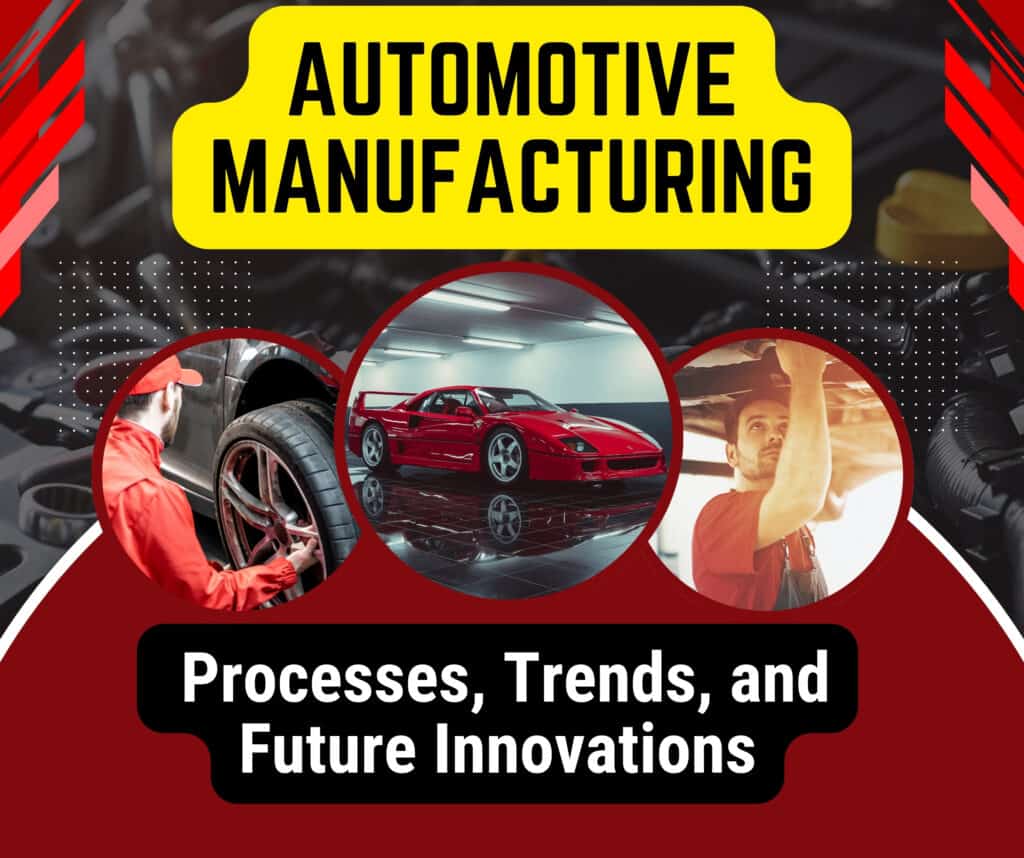Automotive manufacturing is the process of designing, producing, and assembling vehicles, including cars, trucks, and buses. This complex industry combines advanced engineering, state-of-the-art technology, and large-scale production systems to deliver millions of vehicles worldwide each year. From concept design to the finished product, automotive manufacturing involves a series of meticulous steps that ensure the safety, functionality, and efficiency of modern vehicles.
The industry has grown dramatically since the early 20th century, when Henry Ford introduced the moving assembly line, which revolutionized vehicle production. Today, modern automotive manufacturing includes cutting-edge technologies such as robotics, artificial intelligence (AI), and automation, enabling faster and more efficient production than ever before.
Importance of Automotive Manufacturing to the Global Economy
The automotive manufacturing industry is a critical pillar of the global economy, generating billions of dollars in revenue annually and providing employment to millions of people across the world. It is not only central to the economies of leading car-producing nations like the United States, Germany, Japan, and China, but it also supports a vast network of suppliers, component manufacturers, and other related industries.
Here are a few ways the automotive industry impacts the global economy:
- Employment Generation: The automotive sector directly and indirectly employs millions of workers, from factory line employees to engineers, designers, and sales professionals. In major car-producing countries, the industry is often a key contributor to employment rates.
- Contribution to GDP: In many countries, automotive manufacturing is a significant part of the gross domestic product (GDP). The industry’s value chain, from raw material procurement to sales and servicing, adds substantial economic value.
- Innovation Driver: Automotive manufacturing is often at the forefront of technological advancements, pushing innovations in automation, AI, electrification, and green energy, all of which stimulate growth in other industries such as electronics, software, and energy.
Overview of Current Industry Size and Growth Projections
The automotive industry continues to evolve and grow, driven by consumer demand for more fuel-efficient, safer, and technologically advanced vehicles. As of 2024, the global automotive manufacturing market is valued at around $2 trillion, with expectations for steady growth over the coming decade. This growth is fueled by:
- Increasing Demand for Electric Vehicles (EVs): With governments worldwide promoting environmental sustainability and implementing stricter emissions regulations, electric vehicles are becoming a larger share of global car sales. By 2030, it is projected that EVs could make up nearly 30% of global vehicle sales.
- Technological Advancements: The adoption of advanced manufacturing technologies such as AI, robotics, 3D printing, and the Internet of Things (IoT) is driving operational efficiencies, reducing production costs, and improving vehicle quality, leading to higher market expansion.
- Emerging Markets: Rapid urbanization and rising middle-class populations in regions like Asia-Pacific and Latin America are fueling demand for automobiles, contributing to robust market growth.
Start today, succeed tomorrow. Click here to begin your business journey!
Try Wealthy Affiliate (For Free).
What is Automotive Manufacturing?
Automotive manufacturing is the process of designing, assembling, and producing motor vehicles. This highly technical and multi-stage industry encompasses everything from the initial design and engineering of a vehicle to the mass production of components and final assembly. It involves several key processes, including:
- Design and Engineering: This is where ideas and concepts for vehicles are developed and turned into feasible designs, often through CAD (Computer-Aided Design) software. Engineers work to ensure that vehicles meet safety standards, environmental regulations, and performance expectations.
- Parts Manufacturing: The production of individual components like engines, transmissions, and body panels happens at various factories that supply automakers. This includes both in-house manufacturing and outsourcing to third-party suppliers.
- Assembly: Once the parts are manufactured, they are brought together at assembly plants, where vehicles are put together through a highly organized and streamlined process.
The goal of automotive manufacturing is to produce high-quality, safe, and reliable vehicles on a large scale, while keeping production costs low and efficiency high.
Historical Context of the Automotive Industry
The automotive manufacturing industry has come a long way since its humble beginnings in the late 19th century. The invention of the modern automobile is often credited to Karl Benz, who created the first gasoline-powered vehicle in 1885. However, mass production did not begin until the early 20th century.
A significant turning point for automotive manufacturing was the introduction of the moving assembly line by Henry Ford in 1913. Before this innovation, cars were built by hand, which made them expensive and time-consuming to produce. The assembly line allowed workers to specialize in specific tasks and enabled cars to be produced faster and at a lower cost. This was revolutionary, allowing Ford to manufacture the Model T, which became the first affordable car for the masses.
Ford’s assembly line approach became a model for industrial production worldwide, leading to the rapid growth of the automotive industry. By the mid-20th century, automakers in the United States, Europe, and Japan were developing a wide range of vehicles, from luxury cars to affordable, compact cars.
The Evolution of Car Production Techniques
As technology has advanced, so have car production techniques. Some of the most significant evolutions in automotive manufacturing include:
- Automation and Robotics: In the late 20th century, automation began to reshape the industry. Robots were introduced to handle repetitive and dangerous tasks on the assembly line, such as welding and painting. This significantly increased production efficiency, reduced human error, and improved vehicle quality. Today, robots are used extensively throughout the manufacturing process, and some factories are almost entirely automated.
- Lean Manufacturing: Developed by Toyota in the mid-20th century, lean manufacturing aimed to minimize waste and maximize efficiency. It involved streamlining production processes, improving quality control, and reducing unnecessary steps, helping to revolutionize car manufacturing globally. Lean manufacturing is now a standard practice in the industry.
- Modular Production: Automakers began to adopt modular production techniques, where vehicles are built in segments or modules (such as engines, interiors, and body panels) that are assembled separately and then put together in the final stages. This allows for more flexibility in production and makes it easier to customize cars to meet different market demands.
- Sustainability and Green Manufacturing: In recent years, there has been a shift toward more sustainable manufacturing practices. This includes using recyclable materials, reducing energy consumption, and producing electric vehicles (EVs) with lower environmental impact. As governments push for cleaner energy and more stringent emissions regulations, automakers are investing in green technologies and eco-friendly production processes.
- Additive Manufacturing (3D Printing): Another recent innovation is the use of 3D printing for prototyping and even manufacturing car parts. Additive manufacturing allows automakers to create complex components with greater speed and precision while reducing material waste. This technology is still evolving but has the potential to revolutionize the way cars are built.
- Digital Twins and Industry 4.0: The rise of Industry 4.0 has introduced concepts like digital twins, where a digital replica of a manufacturing system or process is created to test and optimize production before implementation. It allows manufacturers to predict problems, test solutions virtually, and improve overall factory efficiency.
Key Processes in Automotive Manufacturing
Automotive manufacturing involves a series of complex, interconnected processes that turn raw materials and ideas into fully functional vehicles. These processes ensure that every vehicle produced meets the required safety, quality, and performance standards. Below is a breakdown of three key processes: Design and Engineering, Assembly Line Production, and Quality Control and Testing.
Design and Engineering
Role of Design in Automotive Manufacturing
The design phase is the starting point of the automotive manufacturing process and plays a crucial role in determining the vehicle’s final appearance, functionality, and performance. Automotive design involves both aesthetic and technical considerations, with designers focusing on aspects such as:
- Exterior Design: The shape, size, and style of the car’s body, including elements like aerodynamics, headlights, and grille design. The goal is to create a vehicle that appeals to customers visually while improving fuel efficiency and stability through optimal aerodynamics.
- Interior Design: Ergonomics and comfort are key priorities for interior designers. The placement of seats, control panels, and safety features are meticulously planned to create a functional and user-friendly environment.
- Concept to Prototype: Designers use advanced software such as CAD (Computer-Aided Design) to create 3D models and prototypes of the vehicle before moving forward with production. This allows for testing of the vehicle’s form, fit, and functionality virtually.
How Engineering Solutions Influence Vehicle Functionality and Efficiency
Once the design is finalized, engineers step in to ensure that the vehicle functions as intended. This phase includes several engineering disciplines:
- Mechanical Engineering: Focuses on designing the vehicle’s core components, such as the engine, transmission, and suspension systems. Engineers aim to maximize performance, durability, and fuel efficiency while ensuring compliance with safety and environmental regulations.
- Electrical Engineering: With the rise of electric vehicles (EVs) and the increasing integration of electronics in cars, electrical engineering is critical. It involves designing everything from the wiring systems to advanced driver-assistance systems (ADAS) and infotainment technologies.
- Materials Engineering: Selecting the right materials is vital for optimizing the vehicle’s weight, durability, and safety. Lightweight materials like aluminum and carbon fiber are increasingly used to improve fuel efficiency without compromising structural integrity.
Engineering solutions directly impact a vehicle’s performance, safety, and environmental efficiency. For example, innovations in engine technology have led to cleaner, more fuel-efficient cars, while advancements in aerodynamics and lightweight materials help improve overall efficiency.
Disclaimer: This post contains affiliate links. If you purchase through them, I may earn a commission at no extra cost to you. These links offer access to valuable resources like training and tools for your online business.
Try Wealthy Affiliate (For Free).
Assembly Line Production
Breakdown of Assembly Line Processes
The assembly line is where the physical production of a vehicle occurs, and it is one of the most critical stages in automotive manufacturing. Here’s how the assembly line typically works:
- Body Shop: In the first stage, the vehicle’s frame is built, typically through welding or fastening processes. Robots often handle welding to ensure precision and safety.
- Paint Shop: Once the vehicle frame is assembled, it moves to the paint shop, where it is coated for corrosion resistance and then painted in various layers. Automation plays a significant role in achieving a consistent finish.
- Engine and Powertrain Installation: In this step, the vehicle’s engine and transmission are installed. These are the core components that determine the vehicle’s performance and drivetrain capabilities.
- Interior and Electronics: Next, interior components like seats, dashboards, and control systems are installed. In modern vehicles, this includes advanced electronics and sensors.
- Final Assembly: In the final stages, the vehicle’s doors, windows, and tires are attached. The vehicle undergoes fluid filling (e.g., fuel, coolant, brake fluid) and alignment.
Each of these processes is carefully coordinated to ensure efficiency and consistency, allowing vehicles to be produced at high volumes while maintaining quality standards.
Innovations in Assembly Line Automation
Automation has significantly transformed the automotive assembly process. Here are a few innovations in assembly line automation:
- Robotics: Robots are used for tasks like welding, painting, and assembly of heavy or repetitive components. This not only increases production speed but also enhances precision and safety.
- AI and Machine Learning: AI-powered systems can monitor production in real time, identifying bottlenecks or potential failures before they occur. Machine learning algorithms can optimize the production line for maximum efficiency.
- Collaborative Robots (Cobots): Unlike traditional industrial robots, cobots work alongside human workers, performing repetitive tasks while humans handle more complex tasks. Cobots improve both safety and productivity.
Automation has allowed manufacturers to reduce costs, improve efficiency, and maintain higher quality control throughout the production process.
Quality Control and Testing
Importance of Quality Assurance
In automotive manufacturing, quality control is paramount. Every vehicle must meet strict safety, reliability, and performance standards before reaching consumers. Quality assurance (QA) ensures that vehicles are free from defects and function as intended under various conditions. Poor quality control can result in recalls, customer dissatisfaction, and reputational damage.
Quality assurance begins at the design and prototyping stage and continues throughout the production process. Manufacturers implement Total Quality Management (TQM) practices, where every step in the manufacturing process is designed to minimize errors and maximize quality.
Methods Used for Vehicle Testing and Safety Standards
Once a vehicle is assembled, it undergoes rigorous testing to ensure it meets the required safety and performance standards. Key methods include:
- Crash Testing: Vehicles are subjected to controlled crash tests to evaluate how they protect occupants in collisions. These tests help assess the effectiveness of safety features like airbags, seatbelts, and crumple zones.
- Durability Testing: Vehicles are driven for thousands of miles under extreme conditions (heat, cold, rough terrain) to assess how well they hold up over time. Components such as engines, brakes, and suspension systems are tested for reliability and durability.
- Emissions Testing: With environmental regulations tightening, manufacturers test vehicles for fuel efficiency and emissions performance. This ensures that the car complies with government regulations on pollution and greenhouse gas emissions.
- NVH Testing (Noise, Vibration, and Harshness): This testing measures how much noise, vibration, and harshness are experienced in the cabin when the vehicle is in motion. Manufacturers aim to reduce these factors to improve the driving experience.
- Software and Electronics Testing: Modern cars are packed with electronics and software, from navigation systems to advanced safety features. These systems are tested to ensure they function reliably and do not interfere with vehicle operation.
Trends Shaping the Future of Automotive Manufacturing
The automotive manufacturing industry is undergoing rapid changes as new technologies, environmental concerns, and evolving consumer preferences drive innovation. Key trends like electric vehicles (EV) production, automation and robotics, and sustainable manufacturing practices are reshaping how cars are made, from the supply chain to the assembly line. These trends are not just transforming the way manufacturers operate, but also the vehicles themselves, leading to more efficient, environmentally friendly, and technologically advanced cars.
Electric Vehicles (EV) Production
The Shift Toward Electric Vehicle Manufacturing
One of the most significant shifts in automotive manufacturing today is the transition from internal combustion engine (ICE) vehicles to electric vehicles (EVs). This change is driven by several factors:
- Government Regulations: Many countries are implementing stricter emissions standards and banning the sale of new gasoline and diesel vehicles by certain dates (e.g., the European Union aims for 2035). This has spurred automakers to accelerate their EV development.
- Environmental Concerns: With growing awareness of climate change and air pollution, both consumers and governments are prioritizing cleaner transportation options. EVs produce zero tailpipe emissions, making them a key solution for reducing global carbon footprints.
- Technological Advancements: Improvements in battery technology, such as longer ranges, faster charging times, and lower costs, have made EVs more practical and appealing to consumers. Additionally, advancements in electric drivetrains and energy recovery systems contribute to the efficiency and performance of these vehicles.
As a result, many automakers are retooling their factories and reshaping their business models to focus on EV production. Major manufacturers like Tesla, Volkswagen, Ford, and General Motors have committed to producing a significant portion of their vehicles as electric over the coming decades.
Impacts of EV on Production Processes and Supply Chains
The shift to EV manufacturing has profound effects on the automotive production process and supply chains:
- Battery Manufacturing: EVs rely on lithium-ion batteries, which require new production facilities and a steady supply of critical materials like lithium, cobalt, and nickel. Many automakers are investing in gigafactories to produce these batteries at scale, and some are forming partnerships with battery suppliers to secure raw materials.
- Simplified Powertrain Assembly: Compared to traditional ICE vehicles, EVs have fewer moving parts. The electric powertrain consists mainly of the battery, electric motor, and power electronics. This simplifies the assembly process, reducing the complexity and number of components required, which in turn leads to lower maintenance costs.
- Supply Chain Disruption: As the industry shifts to EVs, traditional suppliers of engine components, fuel systems, and exhaust systems may face disruptions. At the same time, there’s growing demand for new supply chains around batteries, electric motors, and charging infrastructure. Automakers must establish new relationships and ensure the sustainable sourcing of materials, especially for batteries.
Overall, EV production is transforming how manufacturers operate, requiring them to rethink both their production methods and supply chains to meet the growing demand for electric vehicles.
Automation and Robotics
How Robotics and AI are Revolutionizing Manufacturing
Automation and robotics have long been a part of automotive manufacturing, but recent advancements in Artificial Intelligence (AI), machine learning, and robotics are taking this trend to the next level. These technologies are enabling smarter, faster, and more efficient production processes:
- AI-Powered Robots: In modern factories, robots perform repetitive and precise tasks, such as welding, painting, and assembly. With the integration of AI, robots are now capable of learning from data, making real-time adjustments, and improving their performance over time. This allows for greater flexibility in manufacturing and the ability to handle more complex tasks.
- Collaborative Robots (Cobots): Unlike traditional industrial robots, which are often isolated from human workers for safety reasons, collaborative robots (cobots) are designed to work alongside humans. Cobots can perform repetitive or dangerous tasks, while human workers handle more intricate tasks, improving both productivity and safety.
- Smart Factories: AI and robotics are central to the concept of Industry 4.0, or the “smart factory,” where machines, sensors, and systems communicate with one another. In this environment, AI can analyze data in real time to optimize production schedules, monitor equipment for predictive maintenance, and even suggest improvements in manufacturing efficiency.
Benefits of Automation in Reducing Costs and Increasing Efficiency
Automation brings several significant advantages to automotive manufacturing:
- Increased Productivity: Robots work faster and more consistently than humans, which speeds up production lines and reduces downtime. They can operate 24/7 without fatigue, increasing overall factory output.
- Cost Reduction: While the initial investment in automation technology can be high, it leads to significant cost savings over time. Reduced labor costs, fewer errors, and more efficient use of materials help manufacturers cut down on operational expenses.
- Enhanced Precision and Quality: Robots can perform highly detailed tasks with extreme precision, reducing the likelihood of human error. This ensures a higher level of consistency in vehicle production, improving overall quality and reducing defects.
- Safer Work Environment: Automation takes over dangerous or repetitive tasks, reducing the risk of workplace injuries. Workers can focus on higher-level tasks, leading to a safer and more engaging work environment.
In conclusion, automation and robotics are reshaping automotive manufacturing by improving efficiency, reducing costs, and enhancing production capabilities.
Sustainable Manufacturing Practices
Introduction to Green Manufacturing Techniques
Sustainability is becoming a key focus in automotive manufacturing as companies seek to reduce their environmental impact. Green manufacturing refers to practices that minimize waste, reduce energy consumption, and lower emissions during the production process. This shift is driven by:
- Consumer Demand: More consumers are prioritizing sustainability when choosing vehicles, expecting manufacturers to produce eco-friendly cars using clean production methods.
- Government Regulations: Stricter environmental laws, such as emission standards and waste reduction targets, are compelling automakers to adopt greener manufacturing practices.
Manufacturers are implementing several green techniques, including:
- Energy Efficiency: Factories are becoming more energy-efficient by using advanced lighting, heating, and cooling systems that minimize energy use. Technologies like smart grids and energy management systems help factories optimize power consumption.
- Water Conservation: Many manufacturers are finding ways to recycle and reduce water use during production, especially in water-intensive processes like painting and cooling.
The Role of Renewable Energy and Recyclable Materials
In line with the push for sustainability, automakers are increasingly relying on renewable energy and recyclable materials:
- Renewable Energy: Many automotive plants are transitioning to renewable energy sources such as solar, wind, and hydroelectric power. For example, BMW, Volkswagen, and Tesla have committed to running their factories on 100% renewable energy. This not only reduces their carbon footprint but also lowers operational costs in the long run.
- Recyclable and Eco-Friendly Materials: Automakers are incorporating more recyclable materials into vehicle production. For example:
- Recycled Steel and Aluminum: These materials are commonly used for car bodies and frames. Recycling metals reduces the need for mining, lowering environmental degradation and energy consumption.
- Sustainable Interior Materials: Automakers are increasingly using eco-friendly materials like recycled plastics, organic fabrics, and natural fibers for vehicle interiors. For example, Ford has used soy-based foam for car seats, while BMW offers interiors made from recycled ocean plastic.
- Closed-Loop Manufacturing: Some manufacturers are adopting closed-loop systems where waste from one part of the manufacturing process is reused in another. This reduces waste, conserves resources, and cuts costs.
Create a life of freedom by building your own business. Start now!
Try Wealthy Affiliate (For Free).
Challenges in the Automotive Manufacturing Industry
The automotive manufacturing industry faces a myriad of challenges that can hinder growth, efficiency, and innovation. Understanding these challenges is crucial for stakeholders looking to navigate the complexities of this dynamic sector. Two significant issues currently impacting the industry are supply chain disruptions and labor shortages, both of which require strategic solutions to ensure resilience and sustainability.
Supply Chain Disruptions
The Impact of Global Supply Chain Issues
The automotive industry relies on a complex, global supply chain that involves numerous suppliers, manufacturers, and logistics providers. However, recent events have highlighted vulnerabilities in this system, leading to significant disruptions:
- Pandemic Fallout: The COVID-19 pandemic revealed the fragility of global supply chains. Lockdowns, transportation restrictions, and factory closures resulted in delays and shortages of critical components, including semiconductors, batteries, and raw materials.
- Geopolitical Tensions: Political issues, such as trade wars and sanctions, can disrupt the flow of materials and parts between countries. For example, restrictions on exports from certain countries can create bottlenecks for manufacturers dependent on specific suppliers.
- Natural Disasters: Events like earthquakes, floods, and hurricanes can severely disrupt supply chains by damaging infrastructure and factories. Such disruptions can lead to significant delays in production and increased costs for manufacturers.
These supply chain issues have forced automotive manufacturers to rethink their strategies and adopt more resilient practices.
Strategies for Mitigating Risks in Automotive Production
To address supply chain disruptions, manufacturers are implementing several strategies, including:
- Diversification of Suppliers: By reducing reliance on single suppliers or geographic regions, manufacturers can mitigate risks associated with supply chain disruptions. Developing relationships with multiple suppliers can help ensure a consistent flow of parts and materials.
- Local Sourcing: Some manufacturers are shifting to local or regional suppliers to shorten supply chains and reduce vulnerabilities. Local sourcing can enhance flexibility and responsiveness while also supporting the local economy.
- Supply Chain Visibility: Investing in technology that enhances visibility across the supply chain allows manufacturers to monitor inventory levels, lead times, and potential disruptions in real-time. Advanced analytics and AI can help predict potential risks and enable proactive measures.
- Strategic Inventory Management: Maintaining safety stock or strategic reserves of critical components can provide a buffer against supply chain interruptions. While this approach requires careful management to avoid excess inventory costs, it can be crucial during times of uncertainty.
- Collaboration and Communication: Fostering strong communication and collaboration among suppliers, manufacturers, and logistics providers is vital. Creating transparent relationships can facilitate quicker responses to issues and ensure all parties are aligned.
By implementing these strategies, automotive manufacturers can enhance their resilience to supply chain disruptions and ensure smoother operations.
Labor Shortages and Skills Gap
Challenges in Finding Skilled Labor for Manufacturing
The automotive manufacturing industry is experiencing significant labor shortages, particularly in skilled positions. Several factors contribute to this challenge:
- Aging Workforce: Many skilled workers in the automotive sector are nearing retirement, leading to a shrinking labor pool. The loss of experienced workers can create gaps in knowledge and skills that are difficult to fill.
- Changing Skill Requirements: The industry is rapidly evolving, with advancements in technology, automation, and electric vehicle production. This shift requires a workforce equipped with new skills, and many existing workers may lack the necessary training.
- Perception of Manufacturing Jobs: There is a prevailing perception among younger generations that manufacturing jobs are less desirable compared to careers in technology or other sectors. This mindset can deter potential workers from pursuing careers in automotive manufacturing.
These factors create significant challenges for manufacturers looking to maintain productivity and quality in their operations.
Solutions for Workforce Development
To address labor shortages and close the skills gap, the automotive industry is exploring various solutions:
- Investing in Training and Development: Manufacturers are increasingly investing in training programs to upskill current employees and attract new talent. Initiatives such as apprenticeships, internships, and on-the-job training can help prepare workers for advanced manufacturing roles.
- Partnerships with Educational Institutions: Collaborating with technical schools, community colleges, and universities can help align curricula with industry needs. Manufacturers can work with educational institutions to develop programs that focus on relevant skills and technologies.
- Promoting Careers in Manufacturing: Marketing campaigns aimed at changing perceptions about manufacturing jobs can attract younger workers. Highlighting the advancements in technology, the potential for career growth, and the impact of sustainable manufacturing practices can make these careers more appealing.
- Diversity and Inclusion Initiatives: Expanding recruitment efforts to include underrepresented groups can help tap into a broader talent pool. Programs that promote diversity and inclusion can foster a more innovative and dynamic workforce.
- Flexible Work Arrangements: Offering flexible work schedules, remote work options, and competitive compensation can attract new talent and retain existing employees. Manufacturers can adapt to changing workforce preferences by providing a better work-life balance.
Future Innovations in Automotive Manufacturing
As the automotive manufacturing industry continues to evolve, several groundbreaking innovations are shaping its future. These advancements not only improve efficiency and reduce costs but also pave the way for new production techniques and vehicle technologies. Key areas of innovation include 3D printing, autonomous vehicle production, and digital twins and simulation technology. Each of these developments presents unique opportunities and challenges for the industry.
3D Printing in Automotive Manufacturing
How 3D Printing is Used in Prototype Development and Part Production
3D printing, or additive manufacturing, is revolutionizing the automotive manufacturing process by allowing for rapid prototyping and the production of complex parts. This technology offers several advantages:
- Rapid Prototyping: Automotive manufacturers can create prototypes quickly and cost-effectively, reducing the time from concept to production. With 3D printing, engineers can test designs, iterate on them, and make modifications much faster than traditional methods.
- Customization: 3D printing enables the production of customized parts tailored to specific vehicle models or customer preferences. This level of customization is particularly beneficial for high-performance or luxury vehicles, where unique components may be required.
- Reduced Waste: Traditional manufacturing processes often involve cutting away material, leading to significant waste. In contrast, 3D printing adds material layer by layer, resulting in less waste and more sustainable practices.
- On-Demand Production: Manufacturers can produce parts as needed rather than maintaining large inventories. This approach not only saves space but also reduces the costs associated with excess inventory.
Potential Future Applications of Additive Manufacturing
The potential applications of 3D printing in the automotive industry are vast and growing. Some future applications include:
- Complex Components: As materials and printing technologies advance, manufacturers may be able to produce intricate components that were previously impossible to create with traditional methods, such as lightweight structures or integrated multi-part assemblies.
- End-of-Life Parts: 3D printing could enable the production of replacement parts for older vehicle models, extending their lifespan and reducing waste in landfills. This could also create a market for aftermarket parts produced on-demand.
- Tooling and Fixtures: Manufacturers can use 3D printing to create custom tooling and fixtures, enhancing production line efficiency and reducing setup times.
- Material Innovations: Ongoing research into new materials for 3D printing—such as composites and metals—could open up new possibilities for producing stronger, lighter, and more durable automotive components.
Autonomous Vehicle Production
The Role of Manufacturing in the Rise of Autonomous Vehicles
The emergence of autonomous vehicles (AVs) represents a significant shift in automotive manufacturing. As manufacturers move towards self-driving technologies, several key considerations arise:
- Integration of Advanced Technologies: The production of AVs requires the integration of various technologies, including sensors, cameras, LiDAR, and advanced computing systems. This necessitates new manufacturing processes and supply chains to accommodate these complex components.
- Modular Design: Manufacturers are exploring modular designs for AVs, allowing for easier updates and maintenance of software and hardware systems. This approach could streamline production and reduce costs while enabling manufacturers to keep pace with rapidly evolving technologies.
Challenges and Opportunities in Producing Self-Driving Cars
While the rise of autonomous vehicles presents numerous opportunities, it also brings challenges:
- Regulatory and Safety Concerns: As AVs rely on sophisticated technology, manufacturers must navigate a complex regulatory landscape and demonstrate that their vehicles meet stringent safety standards.
- High Development Costs: Developing AVs requires significant investment in research and development, as well as specialized manufacturing capabilities. Manufacturers must balance these costs with the potential for future profitability.
- Consumer Acceptance: Gaining consumer trust in self-driving technology is essential for widespread adoption. Manufacturers will need to invest in education and marketing efforts to highlight the benefits and safety of AVs.
Despite these challenges, the potential for growth in the AV market is substantial, making it an area of focus for many automotive manufacturers.
Digital Twins and Simulation Technology
Use of Digital Twins to Optimize Production Lines
Digital twins are virtual replicas of physical assets, processes, or systems that allow manufacturers to analyze and optimize their operations. In automotive manufacturing, digital twins play a crucial role in improving efficiency:
- Real-Time Monitoring: By creating digital twins of production lines, manufacturers can monitor performance in real-time. This visibility enables them to identify bottlenecks and inefficiencies quickly.
- Predictive Maintenance: Digital twins can analyze data from machines and equipment to predict when maintenance is needed, reducing downtime and improving overall productivity. By addressing potential issues before they escalate, manufacturers can save costs and enhance reliability.
How Simulations Reduce Costs and Increase Efficiency
Simulation technology complements digital twins by enabling manufacturers to model and analyze various scenarios before implementation. This capability provides several benefits:
- Process Optimization: Manufacturers can use simulations to test different production configurations, identifying the most efficient setups before committing to physical changes. This approach minimizes disruptions and enhances productivity.
- Training and Safety: Simulations offer a safe environment for training employees on new processes and equipment. By simulating real-world scenarios, workers can gain valuable experience without the risks associated with live production.
- Design Validation: Before launching new vehicle models, manufacturers can simulate how changes in design or production techniques will affect performance and costs. This process ensures that potential issues are identified and resolved early in the development cycle.
Conclusion
In summary, automotive manufacturing plays a vital role in the global economy, serving as a backbone for numerous industries and providing millions of jobs worldwide. The sector’s significance extends beyond just producing vehicles; it influences supply chains, impacts technological advancements, and drives economic growth. As we have explored, automotive manufacturing is undergoing a transformative phase characterized by rapid advancements and significant challenges.
Turn your ambitions into achievements. Click here to start your business!
Try Wealthy Affiliate (For Free).
The transition to electric vehicles (EVs) is one of the most noteworthy changes in the automotive landscape. As environmental concerns become increasingly critical, manufacturers are pivoting toward sustainable practices and the development of EVs, which are set to reshape consumer preferences and market dynamics. This shift not only affects vehicle production but also necessitates adjustments in supply chains and infrastructure, promoting the adoption of renewable energy sources and the development of charging networks.
Automation and robotics are another crucial factor shaping the future of automotive manufacturing. These technologies streamline production processes, enhance efficiency, and reduce labor costs. As automation becomes more sophisticated, manufacturers can expect to see improved product quality, shorter lead times, and a more flexible production environment. This evolution enables companies to respond swiftly to market demands and innovate more effectively.
Sustainability is a critical component of the industry’s future, prompting manufacturers to adopt green practices and explore alternative materials. The focus on sustainable manufacturing techniques is not only beneficial for the environment but also aligns with changing consumer expectations, driving brands to build trust and loyalty through responsible practices. By investing in renewable energy, recycling initiatives, and eco-friendly materials, automotive manufacturers can significantly reduce their carbon footprint and contribute to a more sustainable future.
In conclusion, the automotive manufacturing industry is at a pivotal moment, with the convergence of new technologies, changing consumer preferences, and increasing regulatory pressures. Embracing innovation will be essential for manufacturers seeking to remain competitive and relevant in this evolving landscape. As the industry continues to grow and adapt, the emphasis on collaboration, investment in research and development, and a commitment to sustainability will drive its success. The future of automotive manufacturing promises exciting opportunities, and those who harness the power of innovation will undoubtedly lead the way toward a more efficient, sustainable, and technologically advanced industry.
We’d love to hear from you! What are your thoughts on the future of automotive manufacturing? Have you experienced any of the innovative technologies discussed in this article, such as electric vehicles, automation, or sustainable practices? Share your experiences, insights, or questions in the comments below! Let’s engage in a conversation about how these developments are shaping the automotive industry and what they mean for consumers and manufacturers alike. Your voice matters, and we look forward to hearing from you!







